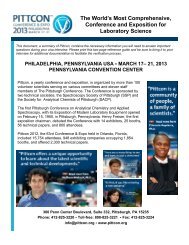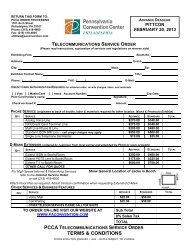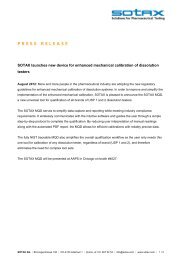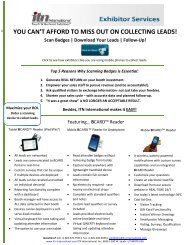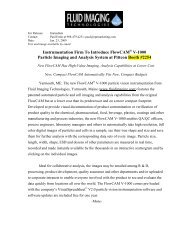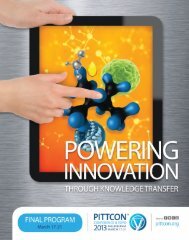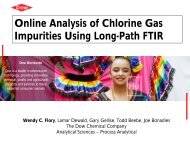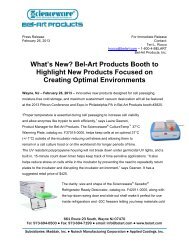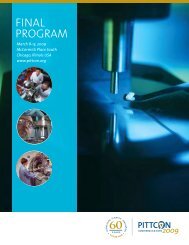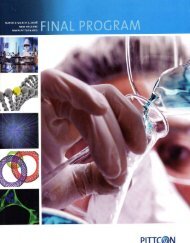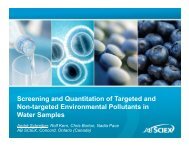2012 Final Program - Pittcon
2012 Final Program - Pittcon
2012 Final Program - Pittcon
Create successful ePaper yourself
Turn your PDF publications into a flip-book with our unique Google optimized e-Paper software.
PITTCON <strong>2012</strong> EXHIBITOR SEMINAR LISTING<br />
EXHIBITOR NAME ROOM # DESCRIPTION<br />
4:00 p.m.<br />
Advanced Incremental ISE Techniques Made Easier<br />
Advanced incremental techniques can seem unnerving. This seminar will review the different incremental techniques, example applications that can<br />
benefit from the various incremental options and how our new Thermo Scientific Orion VERSA STAR meter makes it easier to take advantage of<br />
incremental techniques.<br />
Tuesday, March 13, <strong>2012</strong><br />
10:00 a.m.<br />
Analysis of Carbohydrates using Capillary Ion Chromatography<br />
Capillary Ion Chromatography is the newest Thermo Scientific development. The unique capabilities and advantages of this technique have excited<br />
chromatographers everywhere. The concept of “IC on Demand” has spawned the idea of “Carbohydrates on Demand”. In this presentation, we will<br />
highlight the unique features of the Capillary system, discuss the changes in the electrochemical detector and cell and show the results of analyses. We will<br />
also highlight new column chemistries including monolith and small particle size ion exchangers for the analysis of carbohydrates.<br />
11:00 a.m.<br />
Orbitrap Technology For Enhanced Mass Spec Performance<br />
Learn how high-resolution, accurate-mass (HR/AM) Orbitrap data provides ultimate confidence when you need to identify, quantify and confirm large<br />
numbers of trace-level metabolites, pesticides, or contaminants in complex mixtures - in one analytical run. The availability of HR/AM in a full scan mode<br />
allows retrospective data analysis for qualitative and quantitative applications. It reduces MS method development leading to improved and simplified<br />
analytical throughput.<br />
12:00 p.m.<br />
Chromeleon 7.1 Chromatography Data System: Operational Simplicity for the Enterprise<br />
Operational Simplicity is a key concept in the industry-leading Thermo Scientific Dionex Chromeleon Chromatography Data System (CDS) software version<br />
7.1, which offers the fastest path from samples to results. This presentation will discuss some of the key workflow enhancements for chromatographic<br />
data handling, plus tools and features for wide-scale enterprise deployment.<br />
1:00 p.m.<br />
Converting from HPLC to UHPLC Methods - Eliminating the “Guess Work”<br />
In recent years, there has been a strong and continuing trend towards faster separations in high performance liquid chromatography (HPLC). This is mainly<br />
driven by innovations in HPLC instrumentation and column packing technology. However, in method transfer from HPLC to UHPLC, it is usually sufficient to<br />
maintain the resolution of the original method. Therefore, a popular strategy is to use smaller particles in shorter columns–this approach maintains<br />
resolution and provides faster separations. Rather complex calculations are required to adapt parameters, such as flow rate, injection volume, or gradient<br />
profile, to the new column characteristics. The Thermo Scientific Dionex Rapid Separation LC (RSLC) Method Transfer Calculator is an electronic tool,<br />
embedded in Chromeleon 7.1 that streamlines this process. Optimum instrument settings are automatically calculated based on known parameters of the<br />
conventional HPLC application.<br />
2:00 p.m.<br />
Speciation: Coupling Ion Chromatography with ICP-MS<br />
The Thermo Scientific brand is redefining the field of trace element speciation with our new IC-ICP-MS platforms. The combination of Ion Chromatography<br />
with ICP-MS gives the analyst the ability to gain valuable information in areas such as trace element toxicity by harnessing the ability of ICP-MS to<br />
measure ultra low levels of potentially toxic elements with the versatility of inert, reagent free ion chromatography to identifying the exact chemical<br />
nature of all metallic species. Proof data for the ICS 5000-iCAP Q IC-ICP-MS system will be presented for speciation of elements like Chromium and Arsenic<br />
in a variety of environmental and food matrices.<br />
3:00 p.m.<br />
Meet the Newest Member of the NanoDrop Family: The NanoDrop Lite<br />
The Thermo Scientific NanoDrop Lite is sized right for every bench top and the perfect fit for scientists that need to quantify nucleic acids or purified<br />
proteins, but do not need the full performance, software features, or spectral data that the NanoDrop 2000/2000c or NanoDrop 8000 provide. Learn about<br />
the benefits of this new instrument and how it can expand your labs efficiency with the accuracy and reliability you expect from Thermo Scientific<br />
NanoDrop products.<br />
4:00 p.m.<br />
Choosing the Right GC and GC/MS for your Laboratory<br />
There are many GC and GC/MS technologies available and some can be used interchangeably. During this presentation we will review the technologies<br />
that can be used, where they are used most appropriately, and how to make the best use of them for your laboratory.<br />
Wednesday, March 14, <strong>2012</strong><br />
10:00 a.m.<br />
Capillary Ion Chromatography for Environmental Applications plus EPA Drinking Water Updates for UCMR3<br />
Capillary IC has been shown to greatly improve the sensitivity of several regulated contaminants and disinfection by products including perchlorate,<br />
bromate and haloacetic acids. In a 2-D format, MS detection levels can be achieved in matrix waters. We will also review solutions for contaminants<br />
scheduled for the next Unregulated Contaminant Monitoring Rule 3.<br />
106



